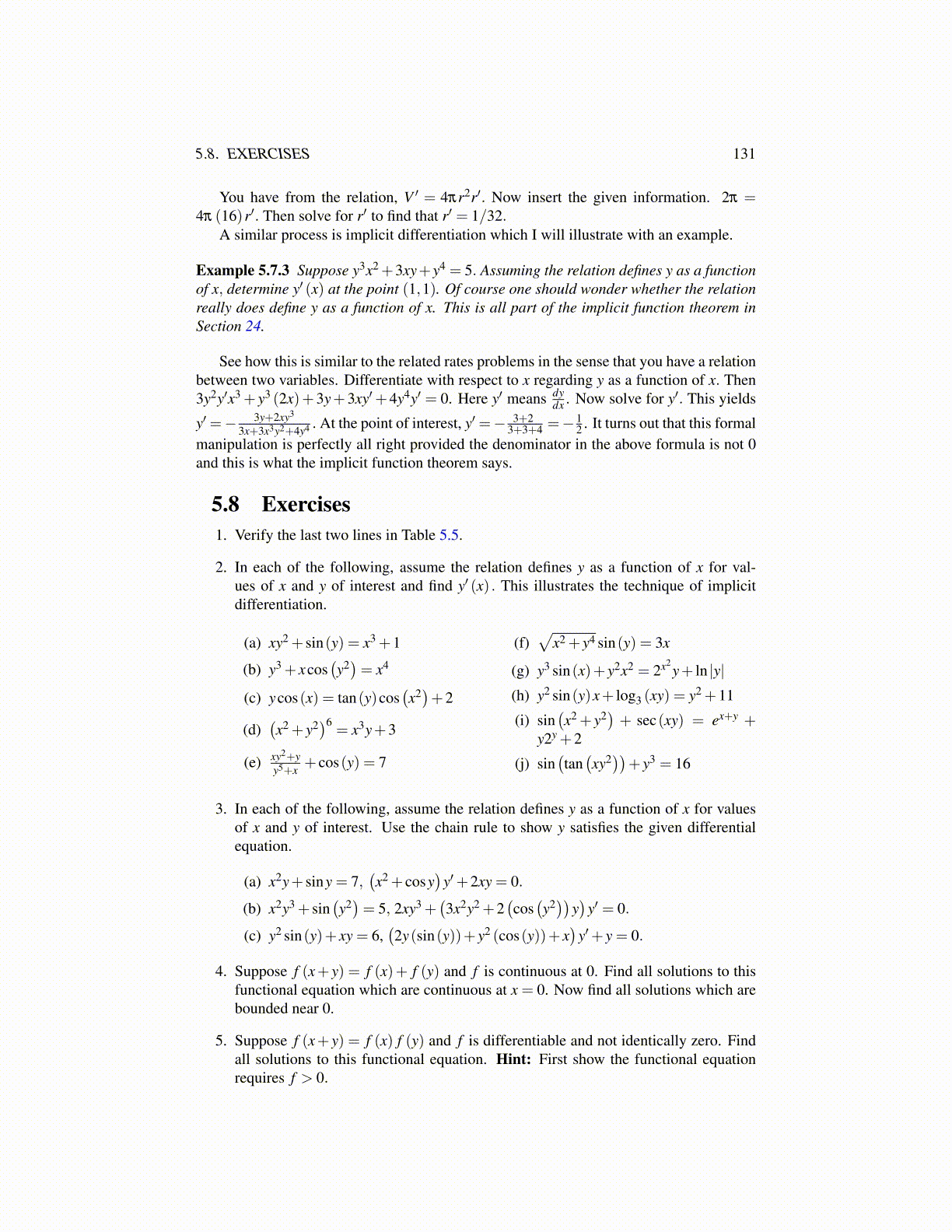
5.8. EXERCISES 131
You have from the relation, V ′ = 4πr2r′. Now insert the given information. 2π =4π (16)r′. Then solve for r′ to find that r′ = 1/32.
A similar process is implicit differentiation which I will illustrate with an example.
Example 5.7.3 Suppose y3x2 +3xy+y4 = 5. Assuming the relation defines y as a functionof x, determine y′ (x) at the point (1,1). Of course one should wonder whether the relationreally does define y as a function of x. This is all part of the implicit function theorem inSection 24.
See how this is similar to the related rates problems in the sense that you have a relationbetween two variables. Differentiate with respect to x regarding y as a function of x. Then3y2y′x3 + y3 (2x)+3y+3xy′+4y4y′ = 0. Here y′ means dy
dx . Now solve for y′. This yields
y′ =− 3y+2xy3
3x+3x3y2+4y4 . At the point of interest, y′ =− 3+23+3+4 =− 1
2 . It turns out that this formalmanipulation is perfectly all right provided the denominator in the above formula is not 0and this is what the implicit function theorem says.
5.8 Exercises1. Verify the last two lines in Table 5.5.
2. In each of the following, assume the relation defines y as a function of x for val-ues of x and y of interest and find y′ (x) . This illustrates the technique of implicitdifferentiation.
(a) xy2 + sin(y) = x3 +1
(b) y3 + xcos(y2)= x4
(c) ycos(x) = tan(y)cos(x2)+2
(d)(x2 + y2
)6= x3y+3
(e) xy2+yy5+x + cos(y) = 7
(f)√
x2 + y4 sin(y) = 3x
(g) y3 sin(x)+ y2x2 = 2x2y+ ln |y|
(h) y2 sin(y)x+ log3 (xy) = y2 +11
(i) sin(x2 + y2
)+ sec(xy) = ex+y +
y2y +2
(j) sin(tan(xy2))
+ y3 = 16
3. In each of the following, assume the relation defines y as a function of x for valuesof x and y of interest. Use the chain rule to show y satisfies the given differentialequation.
(a) x2y+ siny = 7,(x2 + cosy
)y′+2xy = 0.
(b) x2y3 + sin(y2)= 5, 2xy3 +
(3x2y2 +2
(cos(y2))
y)
y′ = 0.
(c) y2 sin(y)+ xy = 6,(2y(sin(y))+ y2 (cos(y))+ x
)y′+ y = 0.
4. Suppose f (x+ y) = f (x)+ f (y) and f is continuous at 0. Find all solutions to thisfunctional equation which are continuous at x = 0. Now find all solutions which arebounded near 0.
5. Suppose f (x+ y) = f (x) f (y) and f is differentiable and not identically zero. Findall solutions to this functional equation. Hint: First show the functional equationrequires f > 0.